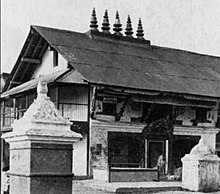367:
people who don't have the initiation of the deity. Devotion to Palah: Dya is commonly believed to ward off troubles and bad omens from one's life. Although religious rites are carried out every day, the temple is frequented mostly on
Saturdays, or on one's birthday. Everything required for worship is available right outside the temple. One can also ask the priests to do some puja for placating one's unfavorable planets and stars. For that, one will have to have oil, iron, black cloth and black lentils. Every 12 years, the priest of the temple, a Buddhist Gubhaju of the Newa Bajracharya clan, worships the deity in a holy pitcher along with another pitcher for Yogini at the Katuwal Daha at Chobhar and then the goddesses are enshrined in the temple. The route of the 12 years jatra is kept secret.
230:
25:
138:
237:
349:
into two different holy pitchers and worshipped them. Later, a temple for the goddess was established during the reign of King
Gunakama Dev. Even today, every 12 years, the priest of the temple, a Buddhist Gubhajyu of the Newa Bajracharya clan, worships the deity in a holy pitcher along with another
366:
The deity is worshiped by following secret
Tantrik rituals. The priest must not be touched at the temple, nor must the statue of the deity. The statue of the deity is draped in cloth covering her body except for her head because the deity is secret Vajrayana deity which shouldn't be seen by the
344:
Legend has it that during the rule of the Malla King
Narendra Dev, a Gubhajyu, a Buddhist Vajrayana Guru, skilled in Tantrik practices, called Bandhu Ratna Bajracharya, with the permission from the king, used his Tantrik powers and brought Sankata and
353:
According to cultural expert Indra Mali, who grew up in Te Bahal, Palah: Dya is not originally from
Kathmandu. There's another legend that states Palah: Dya, as Buddhists call the deity, was brought from Kamaru Kamachya (the present Kamakhya) in
399:
329:. Palah: Dya is a popular divinity for Hindus who is worshipped, especially on Saturdays, to ward off bad luck and sickness. Palah Dya is worshipped by
260:
386:
Kathmandu Valley - The
Preservation of Physical Environment and Cultural Heritage - A Protective Inventory by Carl Pruscha, Vol. 2, Wien 1975
427:
407:
153:
229:
89:
61:
68:
108:
42:
75:
46:
253:
57:
350:
pitcher for Yogini at the
Katuwal Daha at Chobhar and then the goddesses are enshrined in the temple.
35:
336:
This shrine along with
Mahankal Than and Lumadi then are worshipped together on a single day.
82:
8:
168:
310:
421:
275:
262:
322:
188:
24:
330:
318:
207:
158:
192:
137:
346:
355:
326:
217:
175:
333:
as well who accredit the shrine to Chanda
Mahoroshan.
358:. Palah: Dya later became widely known as Sankata.
49:. Unsourced material may be challenged and removed.
419:
394:
392:
389:
382:
380:
361:
180:Chanda Maharoshan or Achala(immovable one)
136:
109:Learn how and when to remove this message
377:
420:
236:
317:), is one of the temples located at
47:adding citations to reliable sources
18:
428:Hindu temples in Kathmandu District
13:
14:
439:
339:
400:"The Sankata Temple at Te Bahal"
235:
228:
23:
34:needs additional citations for
1:
370:
7:
10:
444:
314:
296:
291:
276:27.7023806°N 85.3121500°E
252:
223:
213:
203:
198:
184:
174:
164:
152:
147:
135:
128:
123:
362:Rituals & Festivals
281:27.7023806; 85.3121500
254:Geographic coordinates
244:Location in Kathmandu
16:Hindu temple in Nepal
43:improve this article
404:www.myrepublica.com
272: /
142:Palah: Dya in 1960s
304:
303:
300:King Gunakama Dev
119:
118:
111:
93:
435:
412:
411:
406:. Archived from
396:
387:
384:
316:
287:
286:
284:
283:
282:
277:
273:
270:
269:
268:
265:
239:
238:
232:
140:
121:
120:
114:
107:
103:
100:
94:
92:
58:"Sankata Temple"
51:
27:
19:
443:
442:
438:
437:
436:
434:
433:
432:
418:
417:
416:
415:
398:
397:
390:
385:
378:
373:
364:
342:
280:
278:
274:
271:
266:
263:
261:
259:
258:
248:
247:
246:
245:
242:
241:
240:
143:
131:
115:
104:
98:
95:
52:
50:
40:
28:
17:
12:
11:
5:
441:
431:
430:
414:
413:
410:on 2015-12-22.
388:
375:
374:
372:
369:
363:
360:
341:
340:History/Legend
338:
302:
301:
298:
294:
293:
289:
288:
256:
250:
249:
243:
234:
233:
227:
226:
225:
224:
221:
220:
215:
211:
210:
205:
201:
200:
196:
195:
186:
182:
181:
178:
172:
171:
166:
162:
161:
156:
150:
149:
145:
144:
141:
133:
132:
129:
126:
125:
117:
116:
31:
29:
22:
15:
9:
6:
4:
3:
2:
440:
429:
426:
425:
423:
409:
405:
401:
395:
393:
383:
381:
376:
368:
359:
357:
351:
348:
337:
334:
332:
328:
324:
320:
312:
308:
299:
295:
290:
285:
267:85°18′43.74″E
257:
255:
251:
231:
222:
219:
216:
212:
209:
206:
202:
197:
194:
190:
187:
183:
179:
177:
173:
170:
167:
163:
160:
157:
155:
151:
146:
139:
134:
127:
122:
113:
110:
102:
99:February 2016
91:
88:
84:
81:
77:
74:
70:
67:
63:
60: –
59:
55:
54:Find sources:
48:
44:
38:
37:
32:This article
30:
26:
21:
20:
408:the original
403:
365:
352:
343:
335:
306:
305:
292:Architecture
264:27°42′8.57″N
105:
96:
86:
79:
72:
65:
53:
41:Please help
36:verification
33:
279: /
154:Affiliation
371:References
307:Palah: Dya
124:Palah: Dya
69:newspapers
331:Buddhists
323:Kathmandu
315:पाला: दयो
189:Navaratri
185:Festivals
169:Kathmandu
130:पाला: दयो
422:Category
319:Te Bahal
208:Te Bahal
204:Location
199:Location
165:District
159:Hinduism
148:Religion
297:Creator
214:Country
193:Dashain
83:scholar
347:Yogini
311:Nepali
85:
78:
71:
64:
56:
356:Assam
327:Nepal
218:Nepal
176:Deity
90:JSTOR
76:books
62:news
45:by
424::
402:.
391:^
379:^
325:,
321:,
313::
191:,
309:(
112:)
106:(
101:)
97:(
87:·
80:·
73:·
66:·
39:.
Text is available under the Creative Commons Attribution-ShareAlike License. Additional terms may apply.

